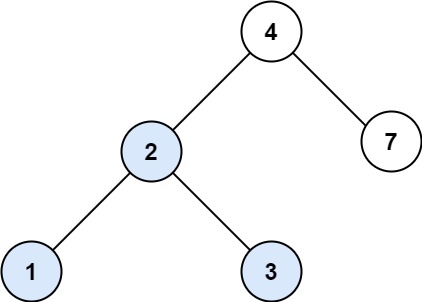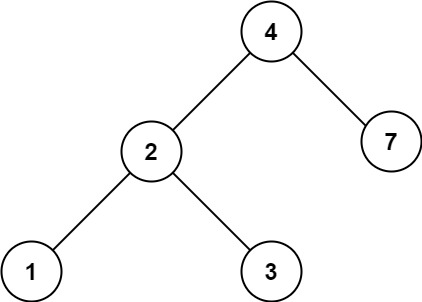Binary Search Trees
 Chetan Datta
Chetan DattaProblem Statement
You are given the root of a binary search tree (BST) and an integer val.
Find the node in the BST that the node's value equals val and return the subtree rooted with that node. If such a node does not exist, return null. (Link)
Example 1:

Input: root = [4,2,7,1,3], val = 2
Output: [2,1,3]
Example 2:

Input: root = [4,2,7,1,3], val = 5
Output: []
Constraints:
The number of nodes in the tree is in the range
[1, 5000].1 <= Node.val <= 10<sup>7</sup>rootis a binary search tree.1 <= val <= 10<sup>7</sup>
Solution
A binary search tree follows one simple condition: left < Node < right. This means that for any node you pick, this rule is followed.
Properties of a BST:
Each left and right subtree is also a BST.
Any subtree is also a BST.
If we assume that 10 is the root, then we can only find the element 5 in the left subtree. If it's not there, we can be sure it is not present in the entire tree.
Recursive Approach
class Solution {
public TreeNode searchBST(TreeNode root, int val) {
if(root == null || root.val==val){
return root;
}
if(val<root.val){
return searchBST(root.left, val);
}
return searchBST(root.right, val);
}
}
Iterative Approach
class Solution {
public TreeNode searchBST(TreeNode root, int val) {
TreeNode temp = root;
while(temp!=null){
if(val<temp.val){
temp = temp.left;
}
else if(val>temp.val){
temp = temp.right;
}
else{
break;
}
}
return temp;
}
}
Subscribe to my newsletter
Read articles from Chetan Datta directly inside your inbox. Subscribe to the newsletter, and don't miss out.
Written by

Chetan Datta
Chetan Datta
I'm someone deeply engrossed in the world of software developement, and I find joy in sharing my thoughts and insights on various topics. You can explore my exclusive content here, where I meticulously document all things tech-related that spark my curiosity. Stay connected for my latest discoveries and observations.